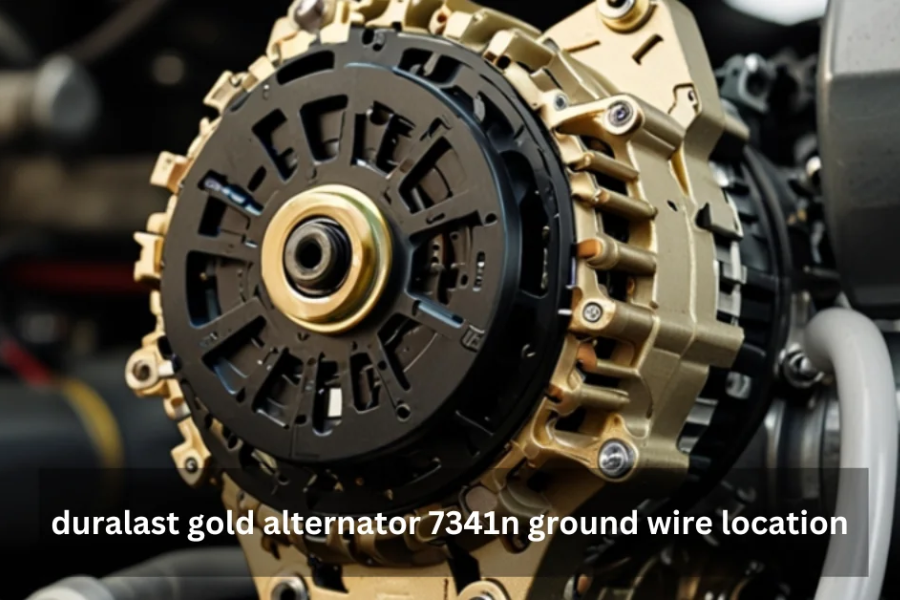Understanding the Importance of the Ground Wire and Its Placement in the Duralast Gold Alternator 7341N
The Duralast Gold Alternator 7341N is widely recognized for its superior performance and reliability, making it an excellent choice for a range of vehicles. To ensure that your alternator continues to function optimally and lasts for years, it is essential to properly understand the location of the ground wire and confirm that it is securely connected. A weak or improper ground connection can result in numerous electrical problems, such as the inability to charge the battery or other system failures. In this article, we will explore the role of the ground wire, where it is located on the Duralast Gold 7341N, and how to maintain it for peak performance.
Why the Duralast Gold Alternator 7341N Relies on a Secure Ground Wire Connection
The Duralast Gold Alternator 7341N Ground Wire Location plays a crucial part in ensuring that your vehicle’s alternator functions smoothly. This alternator is celebrated for its long-lasting durability and excellent efficiency, which helps maintain the electrical system of your vehicle. It supplies reliable power to the system, keeping the battery charged and operational. Duralast, a respected brand in the automotive industry, offers this high-quality alternator as a dependable choice for all your vehicle’s electrical needs. Whether you’re replacing an old or faulty alternator or conducting regular maintenance, the Duralast Gold 7341N is recognized for its reliable output and straightforward installation process
The Crucial Role of a Secure Ground Wire Connection
The ground wire is a key element in the alternator’s operation, serving to complete the electrical circuit. A secure and properly functioning ground wire ensures that the alternator operates efficiently. If the wire is loose, damaged, or corroded, it can disrupt the alternator’s performance, causing a variety of electrical issues. These can range from poor battery charging to malfunctions in other electrical components. Maintaining a solid, corrosion-free ground connection is essential for keeping the electrical system of your vehicle in top condition.
What Is an Alternator, and Why Is It Essential for Your Vehicle?
The alternator is a vital part of the vehicle’s electrical system. It transforms mechanical energy from the engine into electrical energy, which is used to charge the battery and power various electrical systems in the car, including lights, air conditioning, and the radio.
How the Alternator Powers Your Vehicle’s Electrical Systems
Without a functioning alternator, your vehicle would be unable to power its electrical systems. The alternator maintains the battery’s charge and ensures that all electrical components function properly while the engine is running. It’s important to understand that the alternator not only charges the battery but also directly powers the vehicle’s electrical components, which are critical for smooth operation.
Common Problems with Alternators and Their Impact on Performance
Alternator issues are not uncommon and can include worn-out belts, malfunctioning voltage regulators, or a damaged ground wire. These problems often lead to symptoms like dimming lights, electrical failures, or the inability to start the vehicle. Recognizing the root cause of these issues, such as a defective ground wire, is essential for timely repairs and avoiding more significant damage to the alternator and other vehicle components.
The Function and Importance of the Ground Wire in an Alternator
The ground wire is an integral part of the alternator’s electrical circuit, acting as a return path for the current generated by the alternator. For the alternator to function effectively, the ground wire must be securely connected to the vehicle’s chassis.
How the Ground Wire Completes the Alternator’s Circuit
By connecting the alternator to the vehicle’s chassis, the ground wire ensures that electrical current flows efficiently through the system. Without a solid ground, the alternator cannot charge the battery or provide power to the vehicle’s electrical systems.
How Issues with the Ground Wire Can Affect the Alternator’s Performance
If the ground wire becomes loose, corroded, or damaged, it may cause the alternator to fail in charging the battery, which can lead to starting problems and other electrical issues. In some cases, the alternator may not work at all, causing a complete loss of electrical power. Therefore, ensuring a proper ground connection is critical to the alternator’s performance and can help avoid costly repairs.
Finding the Duralast Gold Alternator 7341N Ground Wire Location
The Duralast Gold Alternator 7341N Ground Wire Location is designed for ease of installation and maintenance. Knowing the location of the ground wire is key when installing the alternator or troubleshooting issues.
Identifying the Ground Wire Location on the Duralast Gold 7341N Alternator
On the Duralast Gold 7341N, the ground wire is typically located on the back or side of the alternator facing the engine block. There will be a specific terminal or bolt for attaching the ground wire to the vehicle’s chassis. While this location is usually consistent, it can vary slightly depending on your vehicle’s make and model. Referring to the wiring diagram or the Duralast 7341N installation manual can provide more precise information.
Typical Ground Wire Placement on Most Alternators
Though the ground wire placement might differ slightly across various alternator models, the basic concept is the same: the wire connects the alternator to the vehicle’s chassis, ensuring proper current flow. For most vehicles, this connection is typically found near the mounting bracket or at a dedicated ground terminal on the alternator housing.
How to Identify the Ground Terminal or Bolt on the Duralast 7341N
Look for a terminal or bolt on the Duralast Gold 7341N alternator that may be marked with a “G” or a ground symbol. This is the connection point where the ground wire must be securely attached. Ensuring that the ground connection is clean, free from corrosion, and tightly fastened is crucial for the alternator’s performance.
Step-by-Step Instructions to Locate and Inspect the Ground Wire
Tools You Will Need:
- Socket wrench
- Multimeter
- Flashlight (for low-light environments)
- Wire brush or other cleaning tools for corrosion
- Protective gloves and safety glasses
By using these tools, you can effectively locate and inspect the ground wire to ensure it is in good condition. Proper inspection and maintenance are key to preventing electrical failures and ensuring the longevity of your alternator
Step 1: Ensure Vehicle Safety Before Starting the Inspection
Before beginning any work, turn off the engine and disconnect the battery to eliminate the risk of electrical shock. Always wear the necessary protective gear to safeguard yourself from potential electrical hazards.
Step 2: Locating the Ground Wire on the Alternator
Find the alternator, usually positioned at the front of the engine compartment. Using a flashlight, look for the ground terminal or bolt on the Duralast Gold Alternator 7341N Ground Wire Location. This terminal may have a “G” or ground symbol, marking the point where the ground wire is attached.
Step 3: Checking for Corrosion or Wear on the Ground Wire
Once you’ve identified the ground connection, closely examine both the wire and the connection for signs of wear or corrosion. Corrosion may appear as a greenish buildup around the terminal, and any visible fraying or looseness in the wire could indicate damage.
Step 4: Testing the Continuity of the Ground Wire
Using a multimeter, test the continuity of the ground wire by setting it to the continuity mode. Connect one probe to the alternator’s ground terminal and the other to the chassis of the vehicle. A successful reading confirms the integrity of the ground wire connection, while no reading indicates a potential issue.
Common Problems Resulting from Incorrect Ground Wire Positioning
A defective ground connection can lead to several noticeable problems. Issues such as dimming headlights, erratic dashboard lights, or difficulty starting the vehicle are often caused by an insufficient alternator ground connection, which prevents proper battery charging.
Effect on the Vehicle’s Electrical Components (Battery, Lights, etc.)
When the alternator is unable to charge the battery properly due to a faulty ground connection, the vehicle may experience electrical system failures. The battery might not hold a charge, leaving the car unable to start. Additionally, other electrical systems like lights or air conditioning could begin to malfunction.
Consequences of Poor Grounding Leading to Alternator Malfunction
Loose or corroded ground wires can cause the alternator to overheat, or it may even stop functioning entirely. If not addressed quickly, this can result in expensive repairs, as replacing the alternator might be necessary.
How to Fix Ground Wire Issues on the Duralast Gold Alternator 7341N
If you find that the ground wire is loose, securely tighten it using the correct tools. Ensure the connection is solid on both the alternator and the vehicle’s frame. If the wire is damaged, replacing it with a new one is recommended.
Cleaning Corrosion from Ground Connections
If corrosion is present on the ground wire, use a wire brush to clean the terminal and connection areas. Removing the corrosion restores proper electrical flow, preventing further damage to the alternator and other vehicle components.
Verifying the Ground Connection with a Multimeter
Once you’ve tightened or cleaned the ground wire, use a multimeter to check the connection again. This ensures that the alternator is correctly grounded and will perform optimally.
Troubleshooting Alternator Issues Related to Grounding
If your alternator is not charging the battery effectively, the ground connection may be to blame. Inspect for any visible signs of damage and use a multimeter to check for continuity in the wire.
Duralast Gold Alternator 7341N Ground Wire Location Overview
The Duralast Gold Alternator 7341N is a crucial part of the vehicle’s charging system. It’s essential to understand its installation and maintenance, particularly regarding the ground wire. A secure ground connection ensures optimal performance, preventing issues like alternator failure, inadequate battery charging, or electrical system malfunctions. This guide will walk you through locating the ground wire and troubleshooting any issues for optimal function.
Key Details of the Duralast Gold Alternator 7341N Ground Wire Placement
The Duralast Gold Alternator 7341N is a reliable, high-quality alternator commonly used in various vehicles. The Duralast brand, available at AutoZone, is known for providing durable and dependable replacement parts that contribute to the longevity of your vehicle’s electrical system. The 7341N model ensures efficient power output, and its installation is fairly straightforward for both DIYers and professionals. However, the alternator’s proper grounding is essential to ensure effective performance, proper battery charging, and reliable power for electrical systems.
Why Proper Grounding of the Alternator is Essential
The ground wire plays an integral role in the alternator’s operation, including the Duralast Gold Alternator 7341N Ground Wire Location. It provides the necessary electrical path for the alternator to return current to the vehicle’s chassis or engine block. When the ground connection is weak, loose, or corroded, the alternator may fail to adequately charge the battery, leading to a series of electrical issues.
A weak ground connection can result in:
- Voltage drops that affect alternator power output
- Inconsistent battery charging, which may lead to frequent battery replacements
- Disruptions to other electrical systems, such as flickering lights or malfunctioning air conditioning
- Overheating or malfunctioning of the alternator due to improper grounding
Ensuring that the ground wire is properly secured enhances the alternator’s performance, extending its lifespan and saving you from costly repairs while ensuring the vehicle operates smoothly.
Understanding the Importance of the Alternator in Your Vehicle
Before focusing on the specifics of the Duralast Gold Alternator 7341N Ground Wire Location, it’s important to understand the alternator’s role. The alternator is a vital component of your car’s electrical system. It converts mechanical energy from the engine into electrical energy, recharging the battery and powering various vehicle systems.
Without a properly functioning alternator, your vehicle’s battery would quickly drain, causing the failure of critical systems such as lights, air conditioning, and power steering. The alternator works with the voltage regulator to maintain a steady flow of electricity, ensuring all electrical components receive the necessary power.
Function of the Alternator in Your Car’s Electrical Network
The alternator keeps the battery charged and powers several vehicle systems, including ignition, headlights, and infotainment. It produces alternating current (AC), which is then converted into direct current (DC) by the vehicle’s voltage regulator. This DC power is used to maintain the battery charge and provide electricity to the car’s electrical components.
Common Alternator Problems and Their Effects on Performance
Over time, alternators may experience problems due to poor maintenance or environmental conditions. Some of the most common issues include:
- Worn-out bearings or issues with the alternator belt, affecting the alternator’s rotation
- Damaged diodes, which reduce the power output
- Corrosion or deterioration of the ground wire, disrupting the electrical circuit
When an alternator isn’t functioning properly, it can lead to issues like dim headlights, flickering dashboard lights, or an overall sluggish electrical system. Ensuring proper grounding of the alternator is essential for maintaining peak performance.
The Role of the Ground Wire in Alternator Function
The ground wire is responsible for connecting the alternator to the vehicle’s chassis or engine block, completing the electrical circuit. This wire ensures that the alternator’s electrical energy returns safely to the battery and other systems. Without this proper grounding, the alternator will struggle to discharge electricity correctly, leading to unreliable operation and potential electrical problems.
The Ground Wire’s Role in Maintaining a Complete Circuit
Within the alternator’s circuit, the ground wire provides a return path for electrical current. The alternator generates electrical power, and the current flows through various parts of the vehicle’s electrical system. The ground wire ensures the current has an efficient and safe path back to the alternator and battery, completing the circuit. An improper ground connection can cause excessive heat, overcharging, or undercharging, ultimately leading to alternator failure or damage to sensitive components within the electrical system.
The Impact of Ground Wire Issues on Alternator Performance
When the ground wire is faulty, it can cause voltage drops and lead to irregular alternator function. The electrical system within your vehicle relies on a stable ground to regulate voltage, ensuring the smooth operation of electrical components. A compromised ground connection often results in issues such as battery charging failure, flickering lights, or the appearance of a battery warning light on the dashboard.
Identifying the Ground Wire on the Duralast Gold Alternator 7341N
For optimal alternator performance, it is crucial to locate and inspect the ground wire. On the Duralast Gold 7341N alternator, the ground wire is typically attached to the alternator’s frame, with the other end connecting to the engine block or the vehicle’s chassis. Properly identifying the ground wire’s attachment point will help you ensure the alternator is correctly grounded and functioning efficiently.
How to Find the Ground Wire on the Duralast Gold Alternator 7341N
The ground wire on the Duralast Gold 7341N alternator can usually be found at a small terminal or bolt, which is attached to the alternator housing. Depending on the vehicle model, the wire may run directly from the alternator to the engine block or chassis, connecting the alternator to the vehicle’s larger electrical system. While the ground terminal is generally positioned near the mounting points, its precise location may vary depending on your vehicle’s make and model.
Common Ground Wire Placement on Alternators
For most alternators, including the Duralast Gold 7341N, the ground wire is secured with a bolt or nut. This bolt is usually located at the rear of the alternator where the wire connects to the housing. In some instances, the ground wire might also be attached to a metal bracket or directly to the engine block to ensure the alternator is properly grounded.
Tools Needed to Inspect the Duralast Gold 7341N Alternator Ground Wire
- Multimeter (for testing electrical continuity)
- Wrenches (for removing or tightening the ground wire)
- Clean rags (for cleaning off corrosion)
- Battery terminal cleaner (for corrosion removal)
Step 1: Ensure Vehicle Safety Before Inspection
Start by disconnecting the battery to avoid any accidental short circuits or electrical shocks while working on the alternator. Use a wrench to remove the negative terminal from the battery to ensure your safety during the inspection.
Step 2: Find the Ground Wire Connection on the Alternator
Locate the alternator in the engine compartment and search for the ground bolt or terminal. This is where the ground wire connects the alternator to either the engine block or chassis.
Step 3: Check the Ground Wire for Damage or Corrosion
Once you locate the ground wire, examine it for any visible signs of damage or corrosion. A damaged or corroded ground wire can significantly impact the performance of the alternator, reducing its ability to charge the battery or power other vehicle systems efficiently.
Step 4: Verify the Ground Wire’s Continuity
To confirm the ground wire is functioning properly, use a multimeter to check its continuity. No continuity indicates a break in the circuit, suggesting the alternator may not be grounded correctly, which could cause charging problems.
Common Issues Resulting from Poor Ground Wire Connections
- Visible Symptoms of a Faulty Ground Wire: You might notice dim or flickering headlights, dashboard lights that behave erratically, or electrical problems in various systems.
- Effect on Electrical Systems: An inadequate ground connection can cause inconsistent power delivery, potentially making other systems unreliable or causing them to fail entirely.
- Risk of Alternator Damage: A poor ground connection can cause the alternator to overheat, damaging its internal components and potentially leading to complete failure.
How to Resolve Ground Wire Issues on the Duralast Gold 7341N
If you find the ground wire is loose, use a wrench to tighten the connection at the alternator or engine block. Ensure that the wire is firmly attached and free of corrosion. If tightening doesn’t solve the issue, replacing the ground wire may be necessary.
Cleaning Corrosion from the Ground Wire
If corrosion is present on the ground wire or its connection points, it’s important to clean it thoroughly to restore proper electrical conductivity. Use a battery terminal cleaner or a wire brush to remove any corrosion, and reattach the wire after cleaning to ensure a secure, clean ground connection.
Replacing a Damaged Ground Wire
If the ground wire appears to be damaged, frayed, or has broken insulation, it’s recommended to replace it. Use a wire of similar size and gauge as the original to ensure it can handle the same electrical load, keeping the alternator’s functionality intact.
When to Consult a Professional Mechanic
While inspecting and maintaining the alternator’s ground wire can be a DIY task, there are situations when professional help may be required:
- If you are unable to locate the ground wire or feel uncomfortable working with the electrical system, a mechanic can assist you.
- Extensive corrosion or damage, especially within the alternator itself, might require you to replace the alternator entirely.
- If replacing the ground wire doesn’t resolve the issue, there could be deeper electrical problems that need a mechanic’s diagnostic check.

Best Practices for Keeping Your Duralast Gold Alternator 7341N in Top Condition
- Location of Ground Wire:
The ground wire for the Duralast Gold Alternator 7341N is typically attached to the alternator’s metal casing. The other end of the wire connects to the engine block or the vehicle’s chassis. This grounding ensures the alternator functions efficiently by stabilizing the electrical circuit. - Importance of Proper Grounding:
A proper ground wire connection is essential for maintaining a steady voltage level, which directly affects the vehicle’s electrical systems, such as charging the battery and powering other components. A faulty or loose ground wire can lead to poor performance, including flickering lights or battery charging problems. - Ground Wire Placement:
The ground wire usually connects to the alternator housing using a small terminal or bolt. This attachment ensures the alternator is properly grounded to the vehicle’s electrical system. It may be located near the alternator mounting points, but the exact location can vary depending on the vehicle’s design. - Testing the Ground Wire:
Using a multimeter to test the ground wire for continuity is a critical step in ensuring the alternator’s functionality. If there is no continuity, it indicates a break in the circuit, meaning the alternator is not properly grounded. - Ground Wire Issues:
Symptoms of a faulty ground wire include dimming or flickering headlights, dashboard light malfunctions, or electrical failure in other vehicle systems. These issues arise due to inconsistent power delivery, which is caused by improper grounding. - Maintenance:
Regularly inspect the ground wire for signs of corrosion or damage. Cleaning off corrosion and ensuring a tight connection can help maintain a solid electrical connection, improving the alternator’s performance and longevity. - Replacement of Ground Wire:
If the ground wire is found to be damaged, frayed, or corroded beyond repair, replacing it with one of similar size and gauge is essential for maintaining proper electrical performance. Ensure the replacement wire can handle the same electrical load as the original. - Professional Help:
If you are unsure about locating or inspecting the ground wire, or if extensive damage is found, consulting a professional mechanic can help resolve grounding issues effectively and safely. - Impact on Vehicle’s Electrical System:
An improperly grounded alternator can lead to excessive heat buildup, which can damage the alternator’s sensitive components, ultimately causing it to fail. Proper maintenance of the ground wire helps prevent such issues. - Regular Inspection:
Regularly checking the Duralast Gold Alternator 7341N Ground Wire Location and ensuring it’s in good condition is crucial for long-term alternator performance and avoiding unexpected electrical failures.
Final Thoughts
The Duralast Gold Alternator 7341N is a vital part of your vehicle’s electrical system, ensuring that the battery remains charged and that electrical components continue to operate correctly. Proper grounding is essential for the alternator’s performance, and understanding the location and maintenance of the ground wire is critical for long-lasting functionality.
By regularly checking the ground wire for corrosion, damage, or loose connections, and keeping the system clean, you can avoid issues that might interfere with the alternator’s ability to charge effectively. Timely attention to the ground wire can help maintain your vehicle’s electrical reliability.
Frequently Asked Questions
- Where is the ground wire located on the Duralast Gold Alternator 7341N?
The ground wire is typically found on the alternator’s casing, with the opposite end connected to the engine block or chassis to establish proper grounding. - What is the role of the ground wire in the alternator?
The ground wire ensures that electrical current flows correctly between the alternator and the vehicle’s electrical system, preventing issues like poor charging or electrical failures. - How do I check if the alternator’s ground wire is functional?
Use a multimeter to test the continuity of the ground wire. If the reading shows no continuity or inconsistent results, the ground connection may be faulty. - What problems arise from a loose or damaged alternator ground wire?
A loose or damaged ground wire can result in battery drainage, poor alternator performance, or even complete alternator failure. - Can I replace the ground wire on my Duralast Gold 7341N alternator myself?
Yes, replacing the ground wire yourself is possible. Simply disconnect the old wire, clean the connection points, and install a new wire that matches the original’s size and gauge.
Stay in touch to get more news & updates on Get Break News











